In each question, there is a table having 3 columns and 4 rows. Based on the table, there are 3 questions. Each question has 4 options (a), (b), ( c) and (d), ONLY ONE of these four options is correct.
In the given table, Column I gives masses of rigid bodies, Column II their length and Column III gives their acceleration.
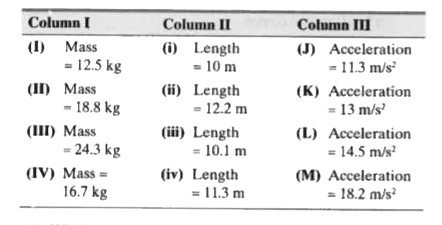
Which object has 2981.7 N as the torque ?
(III) (i) (J)
(I) (i) (L)
(II) (ii) (K)
(II) (iii) (M)
The correct Answer is:C
Step by step video, text & image solution for In each question, there is a table having 3 columns and 4 rows. Based on the table, there are 3 questions. Each question has 4 options (a), (b), ( c) and (d), ONLY ONE of these four options is correct. In the given table, Column I gives masses of rigid bodies, Column II their length and Column III gives their acceleration. Which object has 2981.7 N as the torque ? by Physics experts to help you in doubts & scoring excellent marks in Class 12 exams.
Updated on:21/07/2023Topper's Solved these Questions
- RIGID BODY DYNAMICS - IBook:RESNICK AND HALLIDAYChapter:RIGID BODY DYNAMICS - IExercise:PRACTICE QUESTIONS (INTEGER TYPE))
Explore 3 Videos
- RIGID BODY DYNAMICS - IBook:RESNICK AND HALLIDAYChapter:RIGID BODY DYNAMICS - IExercise:PRACTICE QUESTIONS (LINKED COMPREHENSION)
Explore 7 Videos
- RELATIVITYBook:RESNICK AND HALLIDAYChapter:RELATIVITYExercise:PRACTICE QUESTIONS (Integer Type)
Explore 5 Videos
- RIGID BODY DYNAMICS-IIBook:RESNICK AND HALLIDAYChapter:RIGID BODY DYNAMICS-IIExercise:PRACTICE QUESTIONS (Integer Type)
Explore 2 Videos
Similar Questions
In each question, there is a table having 3 columns and 4 rows. Based on the table, there are 3 questions. Each question has 4 options (a), (b), ( c) and (d), ONLY ONE of these four options is correct.

Which object has 480N⋅m as the resulting torque (as a vector)?
View SolutionThe following tables has 3 columns and 4 rows. Based on each table, there are THREE questions. Each question has FOUR options (A), (B), (C), and (D). ONLY ONE of these four options is correct
Q
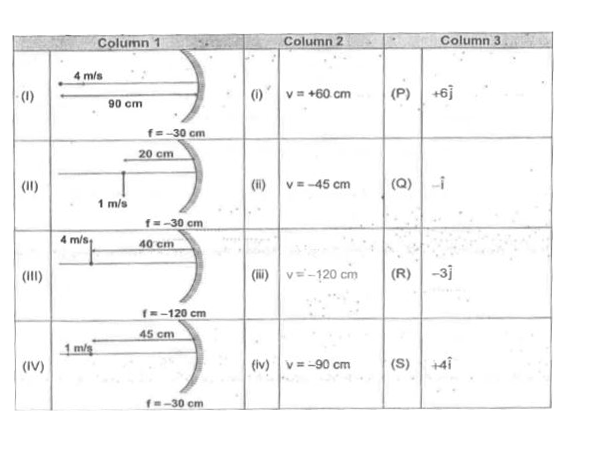
View Solution
Knowledge Check
In each question, there is a table having 3 columns and 4 rows. Based on the table, there are 3 questions. Each question has 4 options (a), (b), ( c) and (d), ONLY ONE of these four options is correct.
In the given table, Column I gives masses of rigid bodies, Column II their length and Column III gives their acceleration.
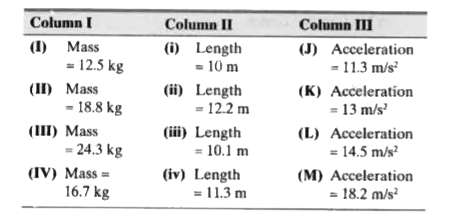
Which object has 1887.1 N as the net torque?A(I) (iii) (K)B(IV) (iii) (L)C(II) (iii) (L)D(IV) (i) (J)In each question, there is a table having 3 columns and 4 rows. Based on the table, there are 3 questions. Each question has 4 options (a), (b), ( c) and (d), ONLY ONE of these four options is correct.
In the given table, Column I gives masses of rigid bodies, Column II their length and Column III gives their acceleration.
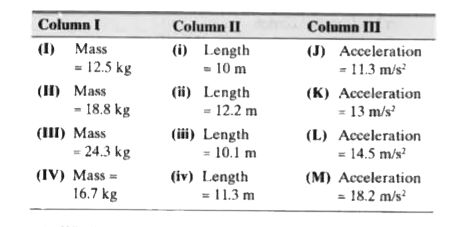
Which object has 2048.13 N as the net torque?A(I) (iv) (L)B(I) (iii) (L)C(II) (i) (M)D(I) (ii) (M)The following table has 3 columns and 4 rows. Based on table there are THREE questions. Each question has FOUR options (A) , (B) , ( C) and (D) . ONLY ONE of these four options is correct
 A(III) (iv) ( R)B(I) (ii) (Q)C(IV) (iii) (R )D(I) (iv) (Q)
A(III) (iv) ( R)B(I) (ii) (Q)C(IV) (iii) (R )D(I) (iv) (Q)
The following tables has 3 columns and 4 rows. Based on each table, there are THREE questions. Each question has FOUR options (A), (B), (C), and (D). ONLY ONE of these four options is correct
Q

View SolutionIn each question, there is a table having 3 columns and 4 rows. Based on the table, there are 3 questions. Each question has 4 options (a), (b), ( c) and (d), ONLY ONE of these four options is correct.
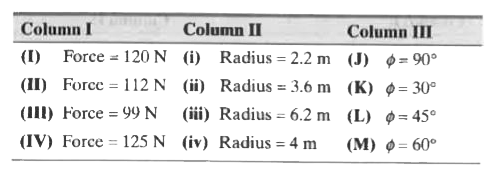
Which object has 137.5N⋅m as the resulting torque (as a vector)?
View SolutionIn each question, there is a table having 3 columns and 4 rows. Based on the table, there are 3 questions. Each question has 4 options (a), (b), ( c ) and (d), ONLY ONE of these four options in correct.
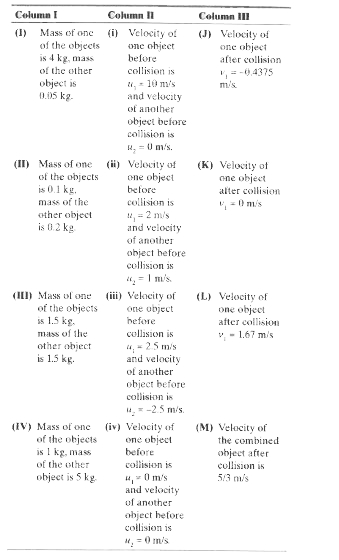
In which condition is the total momentum after collision 10 kg m/s ?
View SolutionIn each question, there is a table having 3 columns and 4 rows. Based on the table, there are 3 questions. Each question has 4 options (a), (b), ( c) and (d), ONLY ONE of these four options is correct.
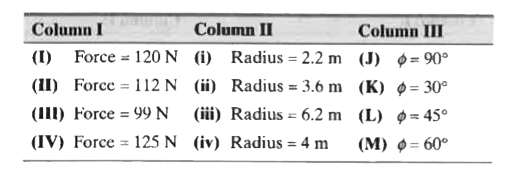
Which object has 178.2√3N⋅m as the resulting torque (as a vector)?
View SolutionIn each question, there is a table having 3 columns and 4 rows. Based on the table, there are 3 questions. Each question has 4 options (a), (b), ( c ) and (d), ONLY ONE of these four options in correct.
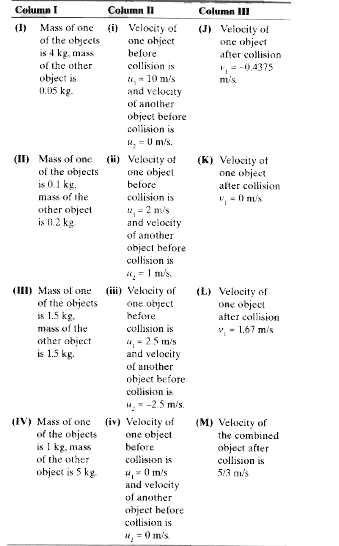
In which condition is the velocity of one of the objects after collision 35 m/s ?
View Solution

